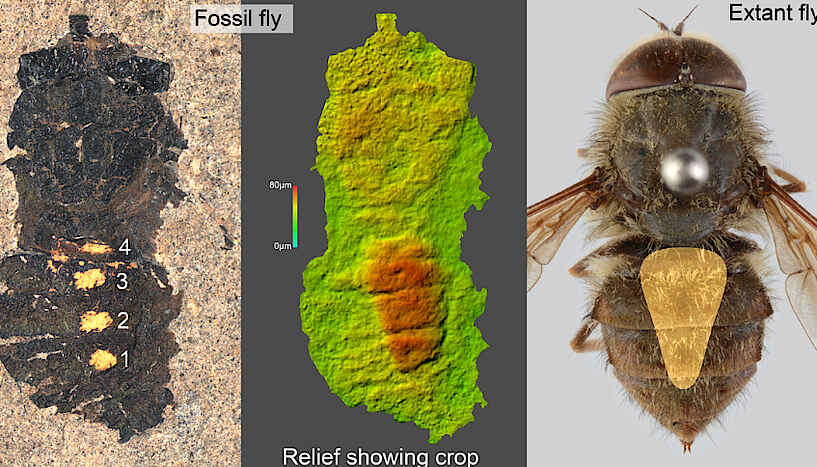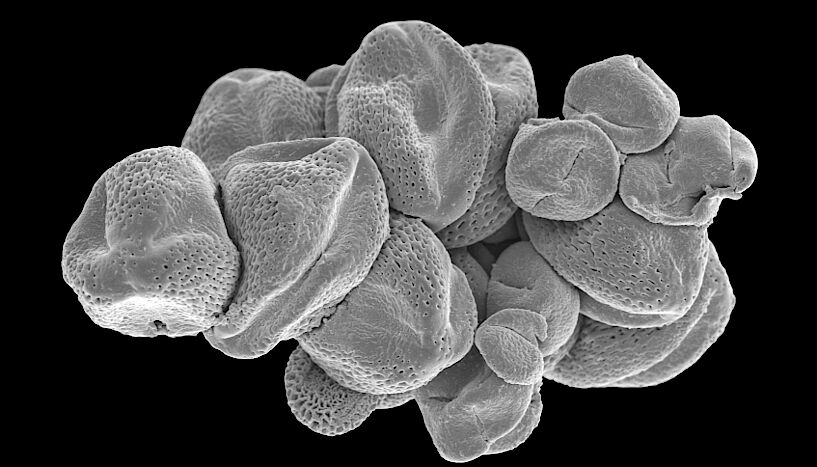
Scientists have found a 47-million-year-old fossilized fly with a bloated belly absolutely stuffed with pollen.
The discovery is that the first evidence that some species of ancient tangle-veined flies once gulped up the microspores of several different species of subtropical plant.
"The rich pollen content we discovered within the fly's stomach suggests that flies were already feeding and transporting pollen 47 million years ago and shows it played a crucial role within the pollen dispersal of several plant taxa," says botanist Fridgeir Grímsson from the University of Vienna, Austria.
When the general public thinks about a pollinator, they imagine a bird, a bee, or a butterfly. only a few consider the fly, although it's generally acknowledged to be the second most vital insect pollinator.
Today, tangle-veined flies with short, tongue-like structures referred to as proboscises, are utterly overlooked as potential pollen carriers. In fact, only modern nemestrinids with long sucking appendages have ever been observed feeding on tubular plants, and even then, only on nectar.
The new fossil, which was found during a disused quarry near Frankfurt, Germany, represents a unique species of ancient, short-proboscid fly (Hirmoneura messelense) that appears to possess had quite the appetite for pollen.
The authors think this pollinating insect may once have even outshined bees.
Fossil records that reveal direct pollen feeding are extremely rare, but the last meal of this fly has been remarkably preserved. Under the microscope, its gut and stomach show traces of pollen from a minimum of four plant families, including water willows and virgin ivy, which probably grew around the forest margins of an ancient lake.
 Fossilized fly and its gut and stomach contents. (Senckenberg)
Fossilized fly and its gut and stomach contents. (Senckenberg)
The researchers could also see long hairs - also referred to as setae - on the fly's thorax or abdomen. While no pollen was found on these hairs, the actual fact that these long bristles exist suggests they may even have transported pollen when the fly bounced from flower to flower.
Unlike other flower-visiting flies with long proboscises, which generally hover above plants to feed, this particular fly probably landed on the tops of flowers, "before engulfing pollen from anthers", the team writes. In fact, the fly's proboscis is so short, it isn't even visible. Researchers think it's probably hidden within the insect's head.
The flowers it seems to possess gobbled are usually packed tightly together, which might have allowed the insect to simply walk between them - eating one meal after another.
Three unknown pollen types within the fly's tummy also suggest it consumed a mixture of parent plants that grew in close proximity.
"It is probably going that the fly avoided long-distance flights between food sources and sought pollen from closely associated plants," explains Grímsson.
 Fossil pollen from the stomach of the fly. (Fridgeir Grímsson)
Fossil pollen from the stomach of the fly. (Fridgeir Grímsson)
While modern flower-visiting flies aren't quite as efficient at transporting pollen as bees, they create up for it through sheer numbers. An investigation into these pollinators has long been neglected and studies are few and much between.
This new discovery supports an old hypothesis that in some modern tropical environments, flower-visiting flies could be a minimum of as important as some pollinating bees - maybe even more so. the very fact that we found pollen within the stomach of an ancient fly suggests this might are a crucial role for the insect as far back because of the Jurassic period.
"The fossil tangle-veined fly presented herein clearly gobbled angiosperm pollen and, consequently, represents the primary evidence of a polliniferous nemestrinid," the authors conclude.
The study was published in Current Biology.
 Reviewed by Admin
on
March 15, 2021
Rating:
Reviewed by Admin
on
March 15, 2021
Rating:



No comments: